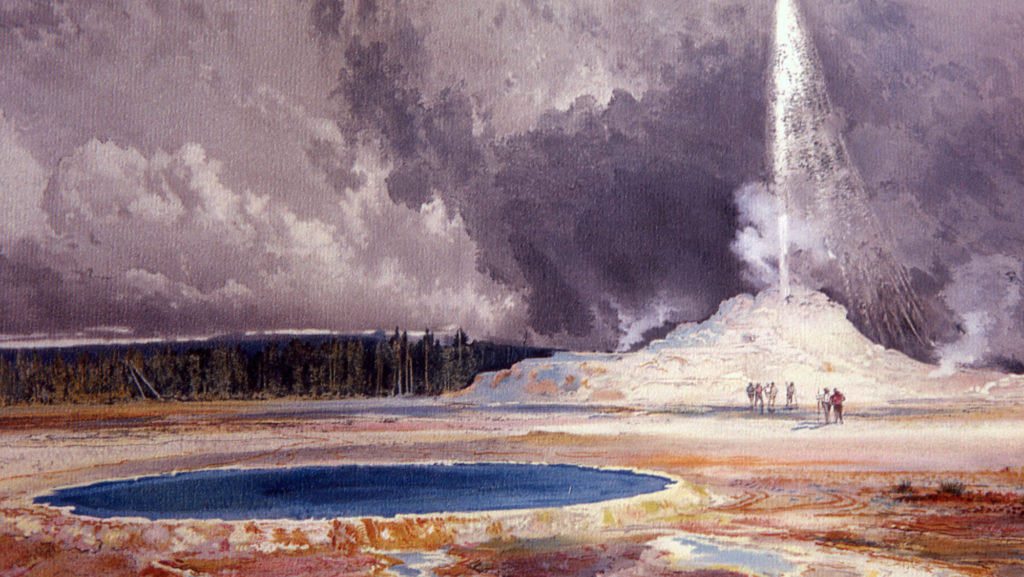Two outstanding items associated with Yellowstone National Park are for sale by Heritage Auctions. A Yellowstone 5 ounce silver coin, and the painting The Yellowstone River by Western artist Tucker Smith.
Preview the auctions and place your bids, and read more about Yellowstone National Park below.
Do you own historical and rare collectible items from Yellowstone? Contact the experts at Heritage Auctions for a free appraisal when you’re ready to sell.
Yellowstone 5 Oz Silver Coin for Sale
2010 25C Yellowstone Five Ounce Silver, First Strike MS68 Deep Mirror Prooflike PCGS.
The Yellowstone River, 1983 by Tucker Smith for Sale
- November 1, 2019 auction date, bidding opens October 11.
- Oil on canvas
- 12 x 18 inches (30.5 x 45.7 cm)
- Signed and dated lower right: Tucker Smith / 83
When Did Yellowstone Become a National Park?
On March 1, 1872, President Grant signed into law “The Act of Dedication,” which established Yellowstone National Park, believed to be the first national park in the world.
It is truly an American treasure and within its 3,500 square miles are hundreds of species of birds, mammals, fish and reptiles, along with vast grasslands and forests. Animal life includes grizzly bears, elk, wolves and the oldest, largest bison herd in the United States.
The Continental Divide of North America runs diagonally through it and separates water drainage of the Pacific and Atlantic oceans. The Grand Tetons are just 10 miles away and 2 million annual visitors know about the “Old Faithful” geyser.
What the people studying Yellowstone’s volcanic history didn’t know was where the park’s volcano actually was. It had been known for a long time that Yellowstone WAS volcanic – that was what accounted for the many geysers and steamy features. But, no one had taken time to find the caldera (a cauldron-like crater), although some did try.
By sheer coincidence, NASA was testing some high-altitude photographs and sent copies to park authorities to use as blowups for use in the visitor centers.
As soon as members of the United States Geological Survey saw the photos, they realized why no one had spotted the caldera. Virtually the entire park was the caldera, all 2.2 million acres of it!
The last volcanic explosion had left a crater 40 miles across, much too large to be seen at ground level.
It turns out that Yellowstone National Park is one giant supernova volcano. For perspective, imagine a pile of TNT the size of Rhode Island, 8 miles high, with all those 2 million visitors casually walking around on top of it.
When (not if) it explodes again, it will spew out enough ash to bury New York State to a depth of 67 feet. It took thousands of workers eight months to clear 16 acres of debris when the World Trade Centers collapsed after 9/11. Imagine how long it would take to clear Kansas!
I hope we will have migrated to Mars by then, since it is not clear how many would survive.
P.S. Yellowstone volcano erupts every 600,000 years on average. The last one was 620,000 years ago.
P.P.S. When we fished on the Yellowstone River, floating tranquilly in a small canoe, our guide advised us the trout were very smart and wily, able to distinguish between real flies and artificial ones. He was right (no fish fry!).
By Jim O’Neal
Jim O’Neal, an avid collector and history buff, is President and CEO of Frito-Lay International [retired] and earlier was Chairman and CEO of PepsiCo Restaurants International [KFC Pizza Hut and Taco Bell]. He is a guest contributor to the Heritage Auctions blog.
